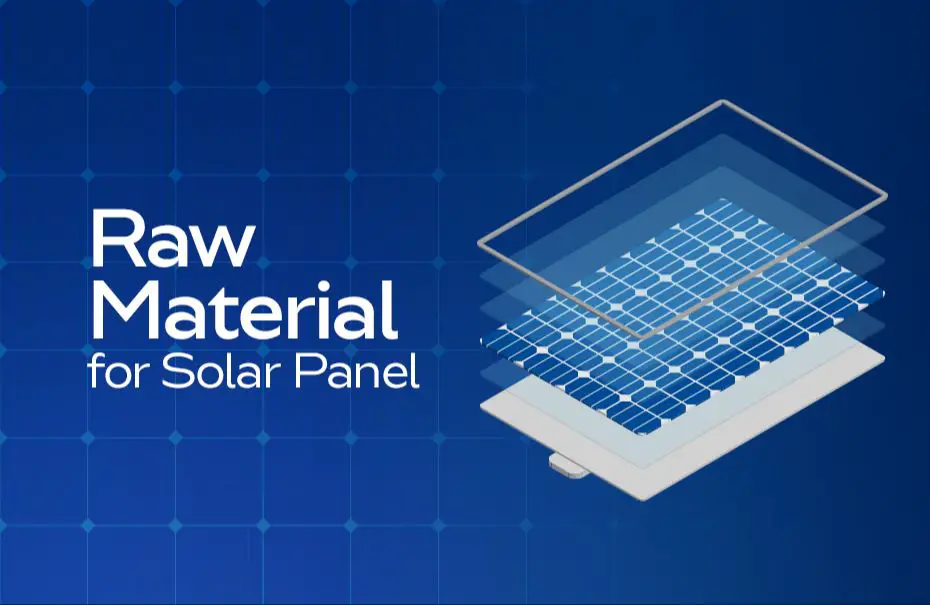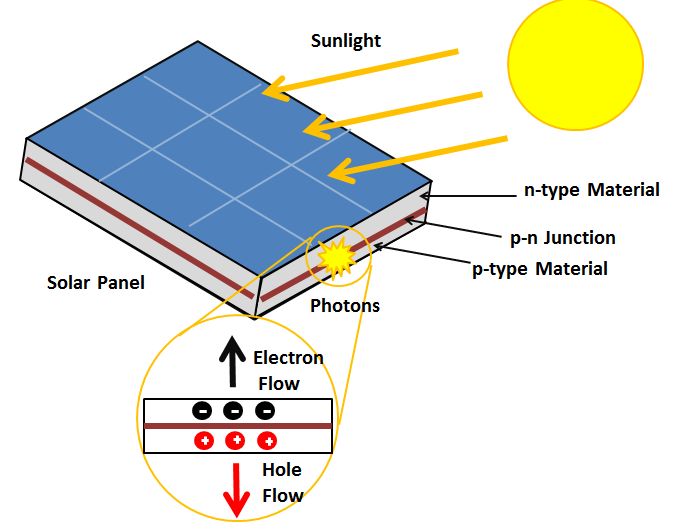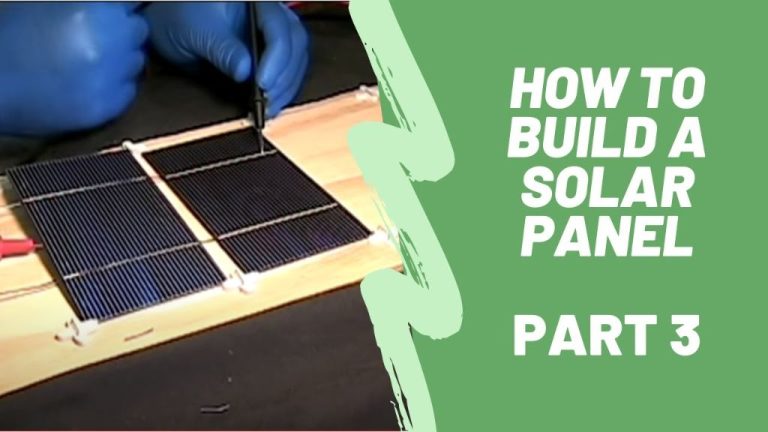What Is The Main Raw Material For Solar Panels?

Solar panels or photovoltaic (PV) cells are devices that convert sunlight into electricity. They are made up of solar cells that contain a photovoltaic material to absorb sunlight and generate an electric current. The most common material used in solar cells today is silicon. Silicon is a semiconductor that has unique properties that make it well-suited for capturing and converting sunlight into electricity. It can be refined into a crystalline structure that allows electrons freed by solar energy to flow through the material and produce power. The purity and crystalline structure of silicon have a large impact on the efficiency and performance of the solar cell. Most of the solar panels available commercially today are made from crystalline silicon wafers, typically mono-crystalline silicon or multi-crystalline silicon.
Silicon
Silicon is the main raw material used in the manufacture of solar panels. Solar cells are made from silicon wafers, which are thin slices cut from a single crystal of silicon (Energy.gov). Silicon is well-suited for solar cells because it is an abundant element, comprising about 25% of the Earth’s crust. It possesses semiconductor properties, which enable it to convert sunlight into electricity (PVeducation.org). Silicon has an ideal bandgap of 1.1 eV, meaning it can absorb photons from the visible light spectrum. It also has low cost, low toxicity, and good temperature stability (AZoM.com).
Silicon Production
Silicon is the main raw material used for solar panels. The silicon used in solar cells is refined and purified through a complex process before it is suitable for manufacturing solar panels.
Silicon is extracted from quartzite rock and processed into metallurgical grade silicon, which is about 98% pure. To reach the 99.9999% purity needed for solar panels, metallurgical grade silicon goes through chemical purification using hydrochloric acid. This produces trichlorosilane gas which is then distilled to produce polysilicon rods (Source 1).
These hyperpure polysilicon rods form the basis of monocrystalline and polycrystalline solar cells. The refined polysilicon is melted and grown into mono-crystalline cylindrical ingots to make monocrystalline silicon cells. For polycrystalline cells, the melted polysilicon is cast into square blocks and cooled (Source 2). This complex process of purifying and refining raw silicon produces the high-purity silicon needed for efficient solar panels.
Other Materials
In addition to silicon, some solar panels are made using other semiconductor materials like cadmium telluride and copper indium gallium selenide (CIGS). These are known as thin-film solar panels and account for a small but growing share of the overall market.
Cadmium telluride (CdTe) is used for thin-film panels that tend to have lower efficiencies than silicon panels, but can be cheaper to manufacture. Some concerns have been raised about the toxicity of cadmium, but manufacturers claim the tiny amounts used pose little risk. CdTe panels currently make up around 5% of the global market.
Copper indium gallium selenide (CIGS) is another thin-film technology that uses less toxic materials than CdTe. CIGS panels have higher efficiencies than CdTe and silicon in the lab, but commercial production lags behind. While more expensive than silicon, CIGS solar continues to improve and gain market share.
Manufacturing Process
The manufacturing process takes raw silicon and turns it into finished solar panels ready for installation. There are several key steps in this process:
First, raw silicon is melted down and formed into ingots or bricks. The silicon ingots are then cut into thin wafers using wire saws or other specialized cutting equipment. These wafers form the base of the solar cells.
The silicon wafers then undergo chemical treatment to texture the surface for better light absorption. The textured wafers are further processed to form the electrical junction and contacts needed to create working solar cells.
The solar cells are then connected together and assembled into complete solar panels with frames, wiring, and other components. Testing occurs at multiple points along the manufacturing process to ensure quality and performance.
Proper manufacturing techniques allow raw silicon to be transformed into highly efficient solar panels ready for installation and electricity generation. The precise process results in wafers cut to just the right thickness and cells optimized for light absorption and energy conversion.
Sources:
https://www.energy.gov/eere/solar/solar-photovoltaic-manufacturing-basics
https://sinovoltaics.com/solar-basics/solar-cell-production-from-silicon-wafer-to-cell/
Panel Components
The main components of a solar panel include the glass, EVA lamination, backsheet, junction box, and aluminum frame.
The glass used on the front of solar panels is low iron tempered glass in the thickness range of 3-4mm. Tempered glass provides rigidity and prevents panel distortion. The glass has a textured surface to maximize sunlight capture. Glass accounts for about 75% of a panel’s weight.[1]
EVA (ethylene vinyl acetate) is the encapsulant material that protects the solar cells. It makes up about 7% of a panel’s weight and laminates the solar cells between the glass and plastic backsheet. EVA prevents moisture and oxygen from corroding the panel components.
The backsheet is made of plastic polymers like polyvinyl fluoride (PVF) or polyvinylidene fluoride (PVDF). It protects the rear of the panel from environmental factors. Backsheets account for about 5% of a panel’s weight.
These materials are layered together and bonded with heat and pressure during the panel lamination process.
[1] https://pt.de.crown-led.com/article/solar-panel-component-materials1-i00036i1.html
Panel Efficiency
The efficiency of a solar panel is determined by how much of the sunlight hitting the panel is converted into usable electricity. One of the key factors impacting efficiency is the quality and purity of the silicon used in manufacturing the solar cells. Higher quality silicon leads to higher performing solar cells.
Silicon is manufactured into either mono-crystalline or multi-crystalline ingots, which are then sliced into wafers for solar cell production. Mono-crystalline silicon results in the highest efficiency cells, with average module efficiencies around 20%. This is because the aligned crystal structure has fewer impurities and defects. Multi-crystalline silicon has slightly lower average efficiencies around 17%, due to the random crystal orientations.1
Improvements in silicon purification and manufacturing processes have steadily increased the efficiency of commercial silicon solar panels over the years. For example, a highly pure form of mono-crystalline silicon called N-type mono has enabled efficiency records over 25%. Reducing impurities leads to higher carrier lifetimes and improved electrical properties.2 Advanced cell structures like back-contact and heterojunction cells also benefit from ultra high-purity silicon to reach record laboratory efficiencies now exceeding 29%.
Recycling
The majority of solar panel materials can be recycled. A key focus of recycling is reclaiming and recycling silicon, which comprises over 90% of solar cells and modules. Recent research has developed methods to recycle silicon wafers from solar panels with high efficiency. For example, scientists at Fraunhofer Institute for Solar Energy Systems have developed a unique process that can reclaim and purify silicon from solar cells with 96% efficiency (https://wanless.com.au/solar-panel-recycling-silicon/). This allows the reclaimed silicon to be reused in new solar panels, creating a circular production system and reducing waste.
Other solar panel components like glass, aluminum and copper can also be recovered through recycling. The recovered materials can be used to manufacture new solar panels or other products. Proper solar panel recycling and reclamation of materials is important for sustainability and reducing environmental impacts. As solar panels increase globally, developing effective recycling processes will be crucial.
Future Materials
Researchers are looking into alternatives to silicon that can make solar panels even more efficient and affordable. One emerging material is perovskites, which are crystals with a specific molecular structure.
Perovskites have shown promise as a possible replacement for silicon in solar cells. They can absorb light across a broader range of wavelengths, allowing the cells to convert more of the sun’s energy into electricity. Perovskites are also cheaper and easier to produce than silicon.
Scientists are studying how to manufacture perovskite solar cells at scale. One challenge is making perovskite materials stable enough for long-term use. Researchers at the University of Groningen used X-ray imaging to observe in situ crystal growth of lead-free perovskites. This helps them understand how to optimize the production process.
Perovskite solar panels are not yet ready for wide-scale commercialization. But they represent an exciting innovation that could eventually displace silicon as the primary solar cell material.
Conclusion
In summary, silicon plays a vital role in solar panels due to its unique semiconducting properties and abundance. When silicon atoms are arranged in a crystalline structure and doped with other elements, they form the P-N junction that enables solar panels to convert sunlight into electricity. Though research is being done on alternative materials like perovskites and organic photovoltaics, silicon remains the dominant material used in commercial solar panels today, making up over 90% of the market. Its reliability, efficiency and cost-effectiveness has solidified its status as the raw material of choice for harnessing the sun’s energy.
Some key facts demonstrating silicon’s importance include:
- Silicon makes up over 90% of today’s solar panels due to its optimized electrical properties for photovoltaics.
- It is one of the most abundant materials on Earth, avoiding supply constraints.
- Silicon cells can reliably convert 10-20% of sunlight into electricity via the photovoltaic effect.
- Manufacturing methods have improved over decades to produce silicon solar panels cost-effectively.
In conclusion, silicon’s role in solar panels is deeply intertwined with its unique properties, abundance, and adaptability to harness the sun’s energy (https://feniceenergy.com/silicons-symphony-in-solar-panels-and-the-p-n-p-junction/). While alternatives are being explored, silicon remains the undisputed champion raw material for solar photovoltaics.






